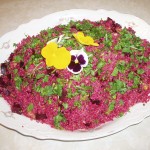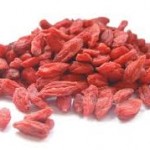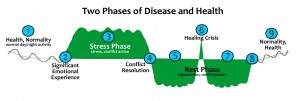Artificial Sweeteners
by Helen Papaconstantinos
As more and more health-conscious consumers are trying to reduce their refined sugar intake and lose weight, Canadians are turning to artificial sweeteners in hope of a quick fix. Consider this: a 355 ml can of soda pop (which contains 10 teaspoons of sugar and 150 calories), daily can add up to a whopping 55,000 calories yearly. When it comes to losing weight, and maintaining health, however, it is not clear that artificial sugars are helping.
Artificial sweeteners are a mix of laboratory chemicals, combined to create a ‘sweet’ taste. Since artificial sweeteners have been introduced, rather than reducing our sugar intake, they have increased it. In a study published in the summer of 2007, researchers from theUniversityofAlbertafound that young animals became desensitized to diet foods, and tended to over-eat during meals of regular-calorie food. The researchers contended that children who consume low-calorie versions of foods that are normally high in calories, may develop “distorted connections between taste and calorie content, leading them to overeat as they grow up”.
Why should this worry us? Artificial sweeteners were created to trick the body into thinking it is getting something sweet. The body, however, is never really tricked and is always looking for balance. Your body still produces insulin in response to artificial sweeteners. When your blood sugar does not increase upon ingesting artificial sweeteners, hypoglycemia may occur, resulting in cravings which lead to increased food intake and sugars at the next meal.
Links between Artificial Sweeteners and Disease
Independent researchers, particularly inEurope, have found popular sweeteners such as sucralose and aspartame to be harmful to human health. Other research studies have linked artificial sweeteners to weight gain, disruption of sleep patterns, fertility problems, development of multiple sclerosis-like symptoms, increase in metabolic syndrome and Type 2 diabetes, and other pathological conditions. ,
The most widely-used artificial sweetener, ‘Aspartame’ is made up of three chemicals: the amino acids aspartic acid, phenylalanine and methanol. In this unbound or ‘free’ form, the body breaks aspartame down rapidly into the toxic by-products formic acid (an irritant found in red ant venom), and DKP (aspartylphenylalanine diketopiperine), an agent linked to gene mutations. It may also contain unknown toxins. Until 1999, people were unaware that Monsanto, the GM food giant, used genetically engineered bacteria to make aspartame for theUSmarket.
At temperatures above 95 degrees (the human body is 98 degrees) aspartame converts to formaldehyde. Formaldehyde, an embalming preservative for laboratory specimens, is no longer used because it has been shown to be a powerful carcinogen. According to Neurosurgeon Dr. Russell L Blaylock, damages various cellular proteins, including enzymes, microtubules and other functional proteins. Even in small concentrations formaldehyde can weaken cells and impair DNA function.
To date, there have been no long-term studies done on humans to determine long-term effects for any sweetener. NutraSweet scientists have claimed for years that most commonly ingested fruit juices contain 140 mg of methanol per litre. This is a fallacy. The 140 mg/litre figure was obtained from a very old conference paper presented by Francot and Geoffroy, who state that they did not perform many of the tests and give no original sources for the work except for the grape juice and black current juice. No methodology was given in their 1956 research.
In nature, methanol never appears alone. In every case, ethanol is present, usually in higher amounts. Ethanol is, in fact, an antidote for methanol toxicity in humans. Aspartame on the other hand, has NO ethanol. Humans are seven times more sensitive to the toxic effects of aspartame or methanol than animals because they lack a couple of key digestive enzymes (such as pectin esterase) to release methanol. Animal testing for methanol or aspartame, therefore, does not adequately reflect the danger for humans.
Why do pop cans have quick expiry dates?
Ever notice how soft-drink companies quickly collect any unsold products from grocery shelves? Soft drinks do not suddenly lose their sweetness when they sit on the shelf — they increase creation of Diketopiperazine (DKP) after being stored more than 6 months. According to FDA toxicologist Dr. Jacqueline Verret, in her testimony before theUS senate, DKP has been implicated as a cause of uterine polyps and changes in blood cholesterol, as well as brain tumour formation. Dr. John Olney, a neuropathologist who worked at the FDA, also noted that DKP, when ‘nitrosated’ in the gut, produced a compound which is similar to N-Nitrosourea, a powerful brain tumour-causing chemical.
How much is too much?
Studies on average daily consumption of artificial sweeteners vary widely. HealthCanada guidelines advise that one can safely consume 40 milligrams of aspartame per kilogram of weight. This means a 68-kilogram person would have to drink about 20 cans a day to get into the aspartame danger zone (a 12-ounce can of diet Coca-Cola contains 120 mgs). One study funded by the National Institutes of Health and the National Cancer Institute, estimated average daily intake to be quite low – the equivalent of just one 12-ounce can of diet soda per day. The researchers, however, made estimates based solely on consumption of beverages containing aspartame, used senior citizens as subjects, relying on their recall of amounts consumed. The Aspartame Information Centre, however, points out that dry goods contain far more aspartame than beverage products.
The bottom line is that people may be consuming more artificial sweetener than they think. Presently, many estimates are inaccurate because they fail to include common daily-use artificial sugar products like table sweeteners, candies, yoghurts, nutrition bars, and chewing gum. The European Ramazzini Foundation’s estimated daily level of 910 mg/day is said to more accurately reflect average daily use of artificial sweeteners. If that sounds excessive, consider that dieters may be consuming even higher amounts. The popular South Beach Diet heavily endorses the use of sugar substitutes despite reports showing that aspartame functions as an appetite stimulant. And when diet is not sufficiently monitored, many people use artificial sweeteners in addition to sugar products.
Independently funded verses industry-funded studies: Whom do we believe?
Questions have been raised about aspartame’s safety and the appropriateness of industry sponsorship of medical research. An analysis of peer reviewed medical literature using MEDLINE and other databases was conducted by Ralph G. Walton, MD, Professor of Clinical Psychiatry, Northeastern Ohio Universities College of Medicine. Dr. Walton analyzed 164 studies felt to have relevance to human safety questions. Of the 90 non-industry-sponsored (independent) studies, 83 (92%) identified one or more problems with aspartame. Of the 74 aspartame industry-sponsored studies, all 74 (100%) claimed that no problems were found with aspartame.
Today, despite controversy and safety issues, artificial sweeteners are used in all types of products – from sports drinks (diet and “regular”), to snack foods, to flu remedies, toothpastes and lozenges. As holistic nutrition professionals, we believe that food should be in its natural, whole state. The best thing to do is avoid all artificial and chemically made sweeteners. They are not real food, trick the body into thinking it is eating something sweet, and carry concerns over safety. Below is a brief overview on a number of artificial sweeteners:
Acesulfame-k or Ace-k (Sunette) – The K is for potassium. Discovered in 1967 this derivative of acetoacetic acid was approved by the FDA in July 1988. Unfortunately, several potential problems associated with the use of this product include lung and other tumours, leukemia, and chronic respiratory disease – even when less than the maximum dose was given. Later it was petitioned for a stay of approval by the FDA due to doubts about its danger.
Aspartame (NutraSweet, Equal, Neotame) – Aspartame has remained controversial since its acceptance as a ‘generally recognized as safe’ (GRAS-listed) additive in 1982. Neotame is Aspartame that has been hydrogenated and linked up with another chemical to make it 30 to 60 times sweeter than Aspartame. Although made from amino acids, aspartame is not a natural substance and many people have experienced nervous system and ‘irritant’ effects such as feelings of agitation, and changes in mood. It has effects similar to those MSG (monosodium glutamate), leading some experts to call it an ‘excitotoxin’. Despite its FDA approval, many members of the health-care profession continue to question its use.
Cyclamate (Sugar Twin, Sucryl) – this chemical sweetener was banned in 1969 in theUS because of cancer-producing tendencies. It is still legal in countries that feel cancer study results on rats are not a cause of concern to humans (i.e.,Latin America). This sweetener is approved as a drug but not a food additive. The Sugar Twin package now carries a label stating that it should only be used under your doctor’s advice, and that it is not safe to use during pregnancy.
Saccharine (Sweet ‘N Low) – In the 1970s there were concerns that saccharine could be cancer causing in laboratory rat studies. Saccharine was not permitted by HealthCanada as a food additive however it allowed consumers access to it as a table-top sweetener. As of November 2009, HealthCanada scientists are still considering re-listing this substance in the Canadian Food and Drug Regulations, following their own safety assessments. Saccharine may be present in drug formulations in substantial amounts.
Sugar Alcohols (Polyols and Polydextrose such as Sorbitol) – Alcohol sweeteners may be better tolerated than aspartame, however, problems such as diarrhoea, dehydration and weight loss may occur because they are not fully digested by the small intestine. Additionally, when undigested carbohydrates reach the colon, the normal bacteria present there, ferments with sugar alcohols to produce gas and bloating. Not surprisingly, sorbitol has been linked to irritable bowel syndrome (IBS). In diabetics, side effects may be more pronounced, because blood glucose is converted into sorbitol at an accelerated rate. Symptoms include damage of the nerves, blood vessels, eyes and kidneys, and formation of cataracts.
Sucralose (Splenda) – was discovered in 1976 by British scientists seeking to create a new pesticide. It is comprised of a sucrose molecule except that three of the hydroxyl groups in the molecule have been replaced by three chlorine atoms. Dr. James Bowden, a physician and chemist explains that once chlorinated, sucralose becomes a chlorocarbon (pesticide) in the family of Chlorodane, Lindane and DDT. He warns that chlorocarbons are wholly incompatible with normal human metabolic functioning, and that they damage the liver’s metabolic cells and destroy them” The manufacturer’s own short-term rodent studies showed that very high doses caused shrunken thymus glands, enlarged livers, and kidney disorders. Adverse reactions in humans collected by the Sucralose Toxicity Information Centre include skin rashes, migraine headaches, panic-agitation, dizziness, numbness, diarrhoea, swelling, muscle aches, intestinal cramping and bladder issues.
ALTERNATIVES TO ARTIFICIAL SWEETENERS
As holistic practitioners, we believe it is always preferable to eat ‘naturally sweet’ foods such as whole grains, vegetables, and fruits, rather than look for natural sugar substitutes. ‘Natural’ or not, too much sweetener, in any form, can have a negative effect on health. Fundamental holistic nutrition views fructose ingestion as being at the core of obesity, insulin resistance, vascular disease, fatty liver, diabetes and other diseases. Pasteurized fruit juices, agave and even raw honey should be limited since ‘natural sugars’ often contain a much higher percentage of fructose than high-fructose-corn-syrup (HFCS). Going sugar-free will also ensure you have a better chance at obtaining an adequate level of fibre, vitamins, and minerals. Fructose levels should be kept to below 25 grams a day. If you do insist on using a natural sugar substitute, however, consider:
Stevia – has been championed by holistic/natural foods advocates inCanada and theUS, and is used in several countries –Japan, especially, where it has been safely used for over 30 years. This green-leaf herb is commonly known as ‘the sweet leaf ofParaguay’, contains no calories, no natural sugars, and can be used by people with diabetes, hypoglycaemia, or candidiasis issues. Stevia’s phytonutrient profile includes betacartotene, dulcosides, steviol, and stevioside.
Pure coconut palm sugar – is a natural product made from the nectar of the coconut palm tree. Pure coconut palm sugar has a naturally low glycemic index (35GI) –a measure of how fast the sugar contact of a food is released into your bloodstream. (Regular sugar is 68GI). This has led to claims that it is an ideal sugar substitute for people with diabetes, those looking to control blood sugar, or those on a low-carbohydrate diet). Coconut palm sugar contains minerals such as magnesium, potassium, zinc, and vitamins B and C, and has also been called the most environmentally sustainable sweetener by the Agriculture Organization (FAO) of the United Nations.
Yacon – this raw, low glucose sweetener made from the root of a tuberous vegetable related to the sunflower, and is grown inColumbia and northwestArgentina. It does not cause a rise in blood sugars due to its lower (34%) level of FOS (fructooligosaccharides) and low proportion of simple sugars (e.g., glucose, fructose and sucrose). The human body lacks enzymes to hydrolyze FOS, so it passes through the digestive tract without being metabolized. In this way, FOS acts as a prebiotic. Its marketers claim that the undigested portion of yacon serves as food for “friendly” bacteria, such as Bifidobacterium and Lactobacillus species, in the colon. Yacon roots also contain potassium and antioxidants. Its taste is similar to caramel and molasses.
Raw Honey – Although it is higher on the glycemic index, raw honey contains many nutrients. Raw honeys such as manuka honey, have been demonstrated to have antimicrobrial properties and is rich in antioxidants, phytonutrients and enzymes. LifeMel honey is made by bees fed on Siberian ginseng, Echinacea and Uncaria tomentosa and other herbs. This is the only honey that has been subjected to clinical testing (it was found to prevent chemotherapy-induced pancytopenia – a lowering of red and white blood cells and platelets).
Agave nectar – Very recently, agave syrup has been maligned as having the highest fructose content of any commercial sweetener. This is not entirely accurate. Differences in the plant, and collection practices can mean that the fructose content can average from 70 to 97 percent, whereas high-fructose-corn-syrup (HFCS) averages 55 percent. One brand, Madhava, only uses sap from the Salmiana species of the agave plant, which does not require extensive processing. The juice is collected by hand, and no heat is involved in its removal. Low heat, (below 113F) is only used in processing/removal of water. Nonetheless, the majority of of agave manufacturers do not use Salmiana species and instead rely on chemical or thermal methods to process the starch from its root bub. The Weston A Price Foundation cautions that conventionally made agave is worse for you than HFCS, and should be avoided.
SOME HEALTHY SUBSTITUTIONS TO TRY AT HOME:
Because sugary, convenience foods satisfy hunger, they often replace more nutritious foods and weaken disease resistance. When you feel like snacking or having something sweet, try some of these healthier options instead:
- Because protein helps to stabilize blood sugar and keeps you feeling full longer, aim for protein based snacks such as a soft boiled egg, or a protein smoothie made with hemp seeds, fresh apples, carrots and ginger root;
- Sweeten your organic tea with a cinnamon stick or a vanilla bean;
- Add a splash of blueberry or pomegranate juice to your green tea instead of honey;
- Skip maple syrup. It adds 50 calories and about 12 grams of sugar per teaspoon. Instead use ‘jam’ made of 2 tablespoons chia seed mixed into 1/2 cup organic pomegranate or cherry juice and leave to thicken;
- Make some ginger syrup using stevia. Chop a 5 inch piece of peeled ginger and boil it with 4 cups of water and a half teaspoon of stevia powder. Simmer gently for 8 minutes. This syrup can be stored in the refrigerator for several days.
- Try mock instant tapioca pudding: mix 2 TBS chia seeds into a half cup of almond milk. Leave to gel in the fridge for 2 hours;
- Instead of reaching for ice cream, try a semi-frozen mashed banana with a dusting of finely ground organic cocoa nibs or carob powder;
- Snack on plain organic yoghurt. Vanilla, cinnamon or nutmeg may be added.
- Eat more high-fibre foods such as brown rice, lentils, dried beans and peas. Foods high in fibre help you to feel full. They also stabilize your blood sugar levels.
- Snack on Pumpkin seeds (Pepitas) sprinkled with curry powder;
- Drain and rinse 4 cups of cooked organic chick peas. Toss in olive oil and spices of choice. Place in slow oven (200 F) for 3 hours. They turn out like corn nuts.
- Dried fruits can be high in natural sugars. If you are going to reach for dried fruit, try un-sulphured gogi berries. They are high in antioxidant power and not sweet;
- Most of all, avoid all soft drinks, energy drinks, and so-called vitamin waters (high sugar water with low quality nutrients). Most soft drinks contain phosphoric acid which blocks absorption of calcium and magnesium in the intestines, leading to early osteoporosis, kidney stones, fatigue, high blood pressure, lowered immunity and other health issues.
Click here for the full bibliography for this article [PDF].
This article originally appeared June 2010 on the IHN website: https://www.instituteofholisticnutrition.com/ihn.asp?section=nutrition_research_artificial




